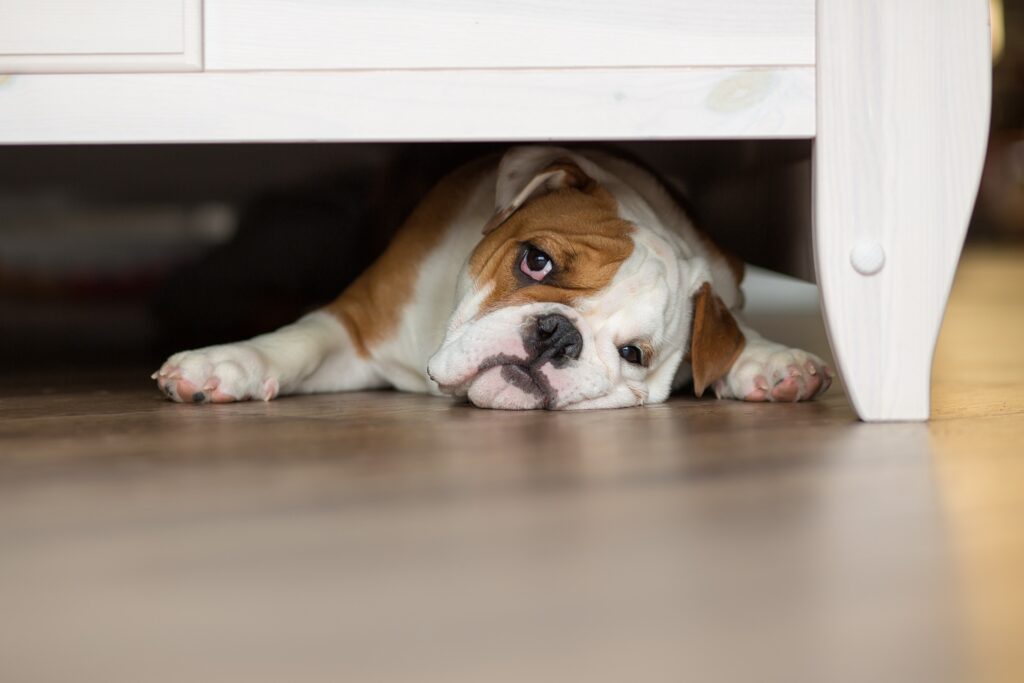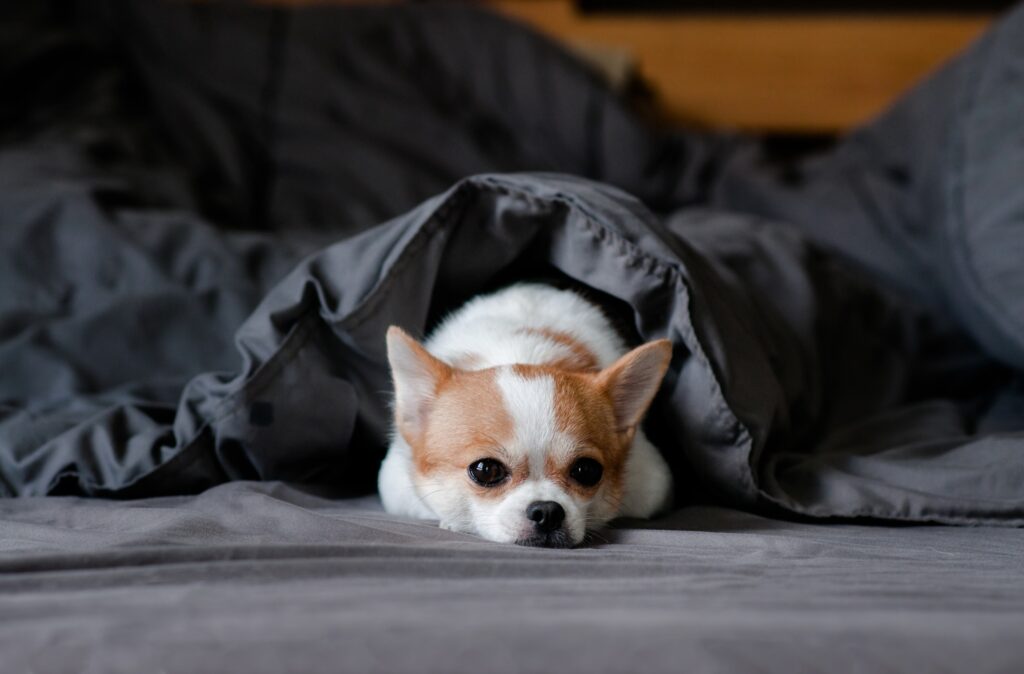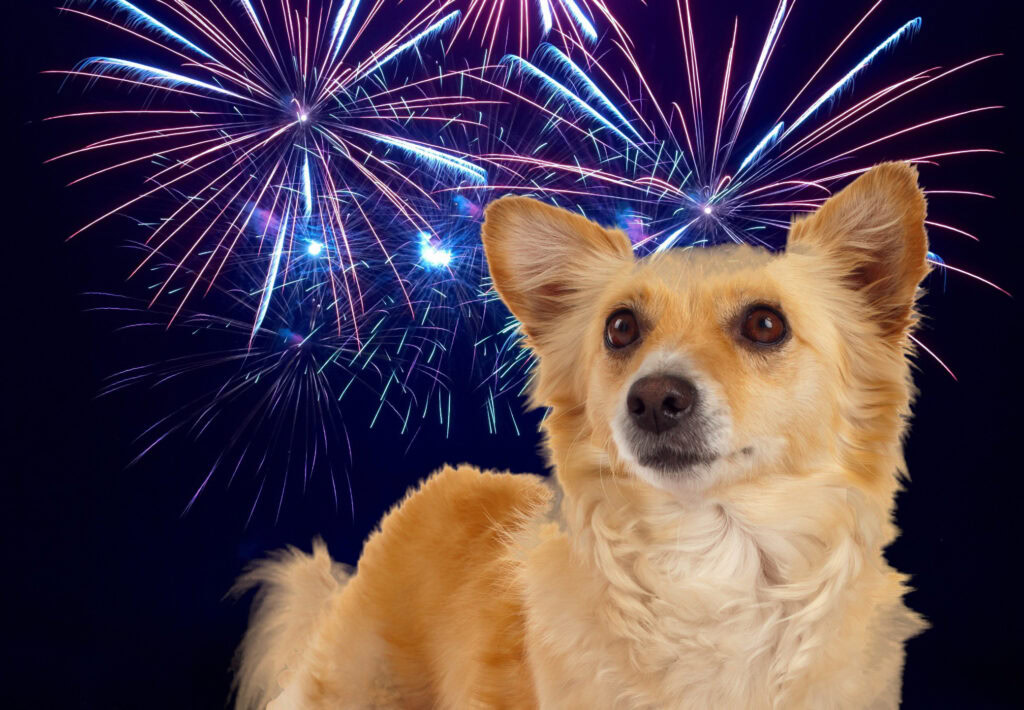Fireworks: a dazzling display of light and color that we eagerly anticipate during celebrations like the Fourth of July. However, for many dogs, the loud noises and sudden bursts are nothing short of terrifying.
As pet owners, it’s heart-wrenching to see our pups in distress. Unfortunately, oftentimes we have no control over things like fireworks displays and other celebration noises.
So what can we do to get our dogs through the festivities without causing them unnecessary stress and anxiety?
Understanding Why Dogs Are Afraid of Fireworks
Dogs have a keen sense of hearing, making them much more sensitive to loud noises like fireworks as compared to humans. The sudden bursts of sound and high pitched whistles, combined with bright flashes of light and unfamiliar smells, can be overwhelming for them.
Moreover, dogs are creatures of habit and routine. They rely on predictability to feel secure in their environment. Fireworks disrupt this sense of normalcy leading to fear responses in dogs.
Dogs that have anxiety triggered by fireworks will usually have one or more of the following reactions:
- Trembling or Shaking: Many dogs shake uncontrollably due to fear.
- Panting and Drooling: Increased stress can cause excessive panting and drooling.
- Hiding or Seeking Shelter: Dogs often try to find a safe place to hide, such as under furniture or in a secluded room.
- Excessive Barking or Whining: Vocal expressions of anxiety are common.
- Destructive Behavior: Some dogs may chew, dig, or scratch doors and windows in an attempt to escape the noise.
- Pacing: Restlessness and continuous movement can indicate distress.
- Loss of Appetite: Anxiety might cause some dogs to refuse food or treats.
- Urinating or Defecating Indoors: Stress can lead to loss of bladder or bowel control.

Behavioral and Environmental Strategies
Managing fireworks anxiety in dogs involves creating a supportive environment and using specific behavioral techniques. Here are some effective strategies:
Creating a Safe and Quiet Space
Designate a quiet, secure area in your home where your dog feels safe. This could be a room with minimal windows or a crate covered with a blanket to reduce noise and light. Include your dog’s favorite bedding, toys, and treats to create a comforting environment.
Having a sanctuary helps reduce anxiety by providing a predictable and secure space.
Using White Noise or Calming Music
Play white noise, calming music, or nature sounds to mask the sound of fireworks. Studies show that classical music, specifically composed for dogs, can have a soothing effect. Devices like white noise machines or apps can help drown out the sudden loud noises, making the environment more tranquil for your pet.
Positive Reinforcement and Desensitization Techniques
Gradual desensitization and counter-conditioning can be effective long-term strategies.
Start by playing recordings of fireworks at a low volume while engaging your dog in positive activities like feeding or playing. Gradually increase the volume over time, ensuring your dog remains calm and engaged. Reward calm behavior with treats and praise, reinforcing a positive association with the sounds.
This process helps reduce the fear response over time, but remember it is not a quick fix and requires patience and consistency.
Seeking Professional Help
If your dog’s anxiety is severe, it may be best to seek professional help. A certified animal behaviorist can develop a personalized treatment plan for your pet, including medication if necessary.
Natural Remedies
Natural remedies may be helpful for calming your dog during fireworks; however, the science supporting this is limited. However, it could be worth a try. You never know – your dog might be one of those that responds very well to these products.
Calming Supplements
Supplements such as L-theanine, melatonin, and Zylkene are popular choices for reducing anxiety in dogs.
- L-theanine, an amino acid found in green tea, promotes relaxation without sedation.
- Melatonin, a hormone that regulates sleep, can help reduce anxiety and improve sleep patterns.
- Zylkene (R), derived from milk protein, has calming properties and can be used as a daily supplement.
Pheromone Products
Dog Appeasing Pheromones (DAP) can be beneficial for calming dogs. These products mimic the natural comforting pheromones released by mother dogs. Available in diffusers, sprays, and collars, DAP products can help create a calming environment by reducing anxiety and promoting a sense of security.
Thundershirts and Other Body Wraps: Thundershirts and similar body wraps apply gentle, constant pressure to your dog’s torso, similar to swaddling an infant.
This pressure can have a calming effect on the nervous system, helping to reduce anxiety during stressful situations like fireworks. Thundershirts are easy to use and can be highly effective for many dogs.

Over-the-Counter Options
Over-the-counter medication for sedating dogs to help them through fireworks are formulated but are generally safe to use in dogs. All of them have some precautions though, and should not be given to dogs with specific health conditions.
Consult with your veterinarian first before giving your dog any of the following medications.
Benadryl (Diphenhydramine)
Benadryl is commonly used to calm dogs, with a typical dosage of 1 mg per pound of body weight, given 2-3 times daily. It works by blocking histamine receptors, which can have a mild sedative effect.
Potential side effects include drowsiness, dry mouth, and gastrointestinal upset.
Precautions include avoiding formulations with alcohol or other active ingredients and consulting a vet, especially if the dog has pre-existing conditions such as glaucoma or cardiovascular disease.
Dramamine, Gravol (Dimenhydrinate)
Dramamine is used to reduce motion sickness and its sedative effects can help calm anxious dogs. The recommended dosage is generally 2-4 mg per pound every 8 hours.
Side effects may include sedation, dry mouth, and urinary retention.
It should be used cautiously and under veterinary guidance, particularly in dogs with underlying health issues.
Melatonin
Melatonin is a natural hormone used to regulate sleep and reduce anxiety in dogs. The dosage typically ranges from 1-6 mg depending on the dog’s size, given 30 minutes before a stressful event. Side effects can include drowsiness and digestive issues. Melatonin should be avoided in pregnant or lactating dogs, and it’s important to consult a veterinarian to determine the appropriate dosage and ensure it is safe for your pet.
Always consult your veterinarian before starting any over-the-counter medication to ensure safety and proper dosage tailored to your dog’s specific needs.
Prescription Medications
Prescription medications for sedating or calming dogs can only be obtained under veterinary prescription and should only be used under veterinary oversight. You must have a valid veterinary-client-patient relationship before before these medications can be prescribed.
Gabapentin
Gabapentin is commonly prescribed for anxiety and sedation in dogs, especially during stressful events like fireworks. It works by stabilizing electrical activity in the brain, which helps reduce anxiety and induce a calming effect.
The typical dosage varies based on the dog’s weight and specific needs, so it’s essential to follow your veterinarian’s guidance.
Potential side effects include drowsiness, ataxia (loss of coordination), and, in some cases, gastrointestinal upset. Long-term use should be monitored by a vet to avoid any adverse effects.
Trazodone
Trazodone is another effective medication for managing anxiety and providing sedation in dogs. It works by increasing serotonin levels in the brain, promoting a sense of calm and relaxation.
Trazodone is often used for situational anxiety, such as during fireworks or thunderstorms. The dosage is determined by the dog’s weight and severity of anxiety, and it should be administered as directed by a veterinarian.
Common side effects include sedation, lethargy, and gastrointestinal issues, though these are usually mild and temporary.
Benzodiazepines (Valium, Xanax)
Benzodiazepines like Valium (diazepam) and Xanax (alprazolam) are used for short-term anxiety relief in dogs. These medications enhance the effect of the neurotransmitter GABA, which has a calming effect on the brain.
They are particularly useful for acute anxiety episodes but should be used with caution due to the potential for dependency and tolerance.
Important safety considerations include avoiding use in dogs with certain medical conditions and monitoring for side effects such as sedation, increased appetite, and, in rare cases, paradoxical excitement.
Long-term Anxiety Medications
Selective serotonin reuptake inhibitors (SSRIs) and tricyclic antidepressants (TCAs) are often prescribed for managing chronic anxiety in dogs.
SSRIs, like fluoxetine (Prozac), and TCAs, like clomipramine (Clomicalm), work by altering neurotransmitter levels in the brain, which helps stabilize mood and reduce anxiety over time. These medications are typically used for long-term treatment and require several weeks to become fully effective.
Regular veterinary monitoring is essential to adjust dosages and manage any side effects, which can include changes in appetite, lethargy, and gastrointestinal disturbances.

Veterinary-Supervised Sedation
Rarely, there are extreme situations where the dog’s response to fireworks is so severe that medications do not work and the animal is likely to do severe harm either to themselves or to their owners. In these cases, veterinarians may recommend an injectable sedation as a last resort to keep everyone safe.
This type of sedation should only be performed under the direction of a veterinarian and with proper monitoring to ensure the dog’s safety while heavily sedated. A veterinarian can provide tailored sedation protocols and immediate care if complications arise, ensuring the safety and effectiveness of the treatment for your dog.
Preparing for July 4th
Importance of a Trial Run with Medications
Consult your veterinarian and make sure you have medications – over-the-counter or prescription – on hand well in advance of the event.0
You will want to conduct a trial run with medications before July 4th to make sure they effectively calm your dog without adverse reactions, with plenty of time to make adjustments if necessary.
The trail run helps determine the right dosage and allows you to observe any side effects, ensuring your dog’s safety and comfort on the actual day.
Make Sure Everything is Ready for Keeping Dogs Calm and Comfortable:
- Create a Safe Space: Set up a quiet, secure area in your home where your dog feels safe. Include familiar bedding and toys.
- Use White Noise: Download white noise, calming music, or nature sounds to your phone or music device for playing during fireworks to mask the noise.
- Be Ready to Provide Distractions: Be ready with engaging toys or treats to keep your dog occupied. Distraction may be the most effective thing you can do to reduce your dog’s fireworks anxiety.
- Stay Calm: Your demeanor can influence your dog’s behavior. Stay calm and reassuring.
- Exercise Beforehand: A well-exercised dog is likely to be more relaxed. Make sure your dog gets plenty of physical activity earlier in the day.
- Consider Calming Aids: Stock up on natural remedies like pheromone diffusers or Thundershirts to help alleviate anxiety.
As a last resort (or it may even be a first option, depending on your own desire to be involved in celebrations or not), consider taking a mini vacation for the day and night and go somewhere with your pup where it will be calm and quiet.
A remote cabin or a camping trip in the mountains could be just what you need to keep your dog comfortable and safe on July 4th.
Wrapping Up
Helping your dog navigate the anxiety induced by fireworks is so important both for their comfort and your peace of mind.
By thoughtfully selecting and implementing a combination of behavioral strategies, natural remedies, over-the-counter solutions, and prescription medications, you can significantly reduce your dog’s stress during these events. Always work closely with your veterinarian to create a personalized plan that addresses your dog’s specific needs.
With proper preparation and care, you can turn a potentially distressing time into a manageable experience for both you and your dog, allowing you to enjoy celebrations without worry.
Happy Fourth of July!
[All images used with permission or under license]

